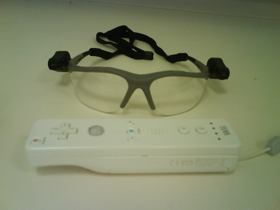

 home
overview
research
resources
outreach & training
outreach & training
visitors center
visitors center
search
search
home
overview
research
resources
outreach & training
outreach & training
visitors center
visitors center
search
search


 home
overview
research
resources
outreach & training
outreach & training
visitors center
visitors center
search
search
home
overview
research
resources
outreach & training
outreach & training
visitors center
visitors center
search
search

Head Tracking via Wii Remote Control
Introduction
UCSF Chimera is a modeling application for displaying molecules, volumes and other three-dimensional objects. To manipulate the objects, users move the mouse. However, a natural tendency when viewing 3D objects is to move one's head to see the side of the object (rather than moving the object). So, we are interested in devices for tracking the user location and movements.Product
On YouTube, researcher Johnny Lee demonstrated how one might use the Nintendo Wii Remote to control an interactive whiteboard, a multitouch surface, and a head-mounted 3D viewer. The latter tracks user (head) position by using the Wii Remote as not as a remote control device, but as a Bluetooth-enabled infrared detector. By placing the Wii Remote in front of the viewing display and having the user put on a pair of glasses with side-mounted IR LEDs, one can construct a simple, low-cost interface that continuously provides spatial coordinates of the user head position.Evaluation
For hardware, we purchased a Wii Remote, two compatible infrared LEDs, and a pair of safety glasses. The LEDs were mounted on both sides of the glasses. For software, we started from the DarwiinRemote code and modified it to generate a stream of 3D coordinates of the detected LEDs on an IP network port. Finally, we modified the Chimera HeadTracker extension, developed for our Camera Mouse experiment, to receive 3D coordinates which are then used to adjust Chimera viewing parameters.
A Wii Remote is used as a detector for the infrared LEDs mounted on safety glasses.Results
We arrived at essentially the same conclusions as we did in the Camera Mouse experiment.Our approach works, but does not substantially add to the user experience. This is because most users are already manually manipulating the models in Chimera, and a simple drag of the mouse will provide the views generated by head motion. As expected, head tracking is most effective when viewing a static scene. Head tracking using a Wii Remote does provide a low-cost (but relatively low-performance) alternative to stereo viewing hardware such as Crystal Eyes.
There are two caveats that we found in our experiment. First, the head tracking approach is not appropriate when more than one user is present since the displayed view reflects the scene as seen by the tracked user. Second, available software for interfacing with the Wii Remote is quite different for the popular platforms of Linux, Mac OS X and Microsoft Windows. Our experiment was done on Mac OS X, but the code is not easily tranferable to the other platforms.
Laboratory Overview | Research | Outreach & Training | Available Resources | Visitors Center | Search